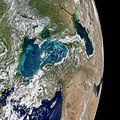Fișier:Turquoise Swirls in the Black Sea.jpg

Mărimea acestei previzualizări: 600 × 600 pixeli. Alte rezoluții: 240 × 240 pixeli | 480 × 480 pixeli | 768 × 768 pixeli | 1.024 × 1.024 pixeli | 2.048 × 2.048 pixeli | 7.000 × 7.000 pixeli.
Mărește rezoluția imaginii (7.000 × 7.000 pixeli, mărime fișier: 16,71 MB, tip MIME: image/jpeg)
Istoricul fișierului
Apăsați pe Data și ora pentru a vedea versiunea trimisă atunci.
| Data și ora | Miniatură | Dimensiuni | Utilizator | Comentariu | |
|---|---|---|---|---|---|
| actuală | 12 iunie 2017 11:55 |  | 7.000x7.000 (16,71 MB) | Originalwana | {{Information |Description ={{en|1=Most summers, jewel-toned hues appear in the Black Sea. The turquoise swirls are not the brushstrokes of a painting; they indicate the presence of phytoplankton, which trace the flow of water currents and eddies. O... |
Utilizarea fișierului
Următoarele pagini conțin această imagine:
Utilizarea globală a fișierului
Următoarele alte proiecte wiki folosesc acest fișier:
- Utilizare la ar.wikipedia.org
- بوابة:محتوى متميز
- ويكيبيديا:صور مختارة
- ويكيبيديا:صور مختارة/الفضاء والكون
- ويكيبيديا:صور مختارة/الفضاء والكون/نظرة إلى الخلف
- بوابة:محتوى متميز/محتويات
- بوابة:محتوى متميز/محتويات/صور مختارة
- بوابة:محتوى متميز/الرئيسية
- علوم الأرض ناسا
- ويكيبيديا:يوم ويكيبيديا العربية التاسع عشر
- مستخدم:أيوب/يوم ويكيبيديا العربية التاسع عشر
- ويكيبيديا:يوم ويكيبيديا العربية التاسع عشر/تنفيذ الأهداف
- ويكيبيديا:ترشيحات الصور المختارة/البحر الأسود
- ويكيبيديا:صورة اليوم المختارة/أغسطس 2023
- قالب:صورة اليوم المختارة/2023-08-31
- Utilizare la be-tarask.wikipedia.org
- Utilizare la bn.wikibooks.org
- Utilizare la crh.wikipedia.org
- Utilizare la cs.wikipedia.org
- Utilizare la cv.wikipedia.org
- Utilizare la dz.wikipedia.org
- Utilizare la en.wikipedia.org
- Utilizare la fa.wikipedia.org
- Utilizare la fa.wikibooks.org
- Utilizare la frp.wikipedia.org
- Utilizare la fr.wikipedia.org
- Utilizare la gl.wikipedia.org
- Utilizare la he.wikipedia.org
- Utilizare la hu.wikipedia.org
- Utilizare la hy.wikipedia.org
- Utilizare la hy.wikibooks.org
- Utilizare la it.wiktionary.org
- Utilizare la ka.wikipedia.org
- Utilizare la ko.wikipedia.org
Vizualizați utilizările globale ale acestui fișier.




